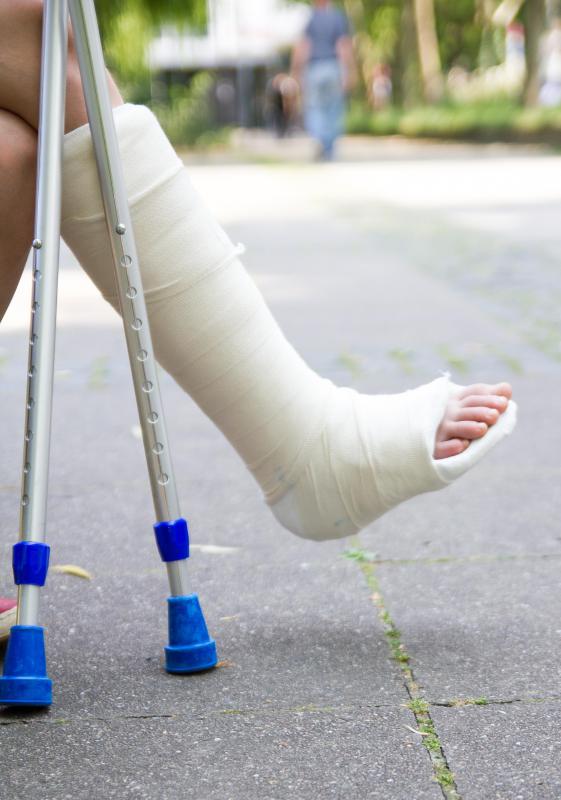At TheHealthBoard, we're committed to delivering accurate, trustworthy information. Our expert-authored content is rigorously fact-checked and sourced from credible authorities. Discover how we uphold the highest standards in providing you with reliable knowledge.
What Is the Distal Fibula?
The distal fibula is the lower part of the fibula, which is one of the bones that forms the lower leg. This bone, along with two other bones, helps form one of the joints of the ankle. Young children have a growth plate in their distal fibulas. If a growth plate is broken, it can lead to deformities in adulthood. Treatment for a fracture in this region usually involves a cast.
The fibula is the bone located on the lateral side of the tibia. Together, these two bones make up the lower leg. The distal fibula is the lower portion of the fibula, located at the ankle.

Feet are able to pivot because of the ankle joint, which is made up of the tibia and talus, along with the distal fibula. The tibia is on the inside of the ankle, and the talus is at the bottom of the ankle. The distal fibula is located on the outside of the ankle, and it can be seen protruding slightly on the side of the ankle.
Children have something called a growth plate located in their distal fibulas. Growth plates consist of cartilage, a substance that is softer than bone and can stretch as children grow. As people get older, these plates will turn completely to bone.

A fractured distal fibula is a somewhat common injury, especially in very active people. Fractures that break the growth plate in a child can be serious. If these fractures do not heal correctly, they can cause deformities. Some children who have a fracture on this area, for example, may have one leg that is slightly shorter than the other.
Broken ankles usually occur when people twist their ankles. These are often mistaken for sprained ankles. These two injuries have similar symptoms.
Pain is one of the main symptoms of a fractured distal fibula. This pain will usually be the worst on the outside of the ankle. Most people with this type of injury are unable to put weight on the injured ankle. Swelling and bruising may also occur.

X-rays are usually used to diagnose a fractured distal fibula. After the diagnosis, the fractured bones are positioned back together as close to their natural positions as possible. A cast is then used to hold the fractured bones together, and it will usually take a couple months for the bone to heal completely.
Frequently Asked Questions
What is the distal fibula?

The distal fibula is a lower leg bone below the knee joint. It is the smaller of the lower leg's two bones; the other is the tibia. The distal fibula connects the knee and ankle joints on the lateral side of the leg. It is in charge of giving the ankle joint stability and strength. Additionally, it facilitates movement by absorbing shock and tension.
What does the distal fibula do?

The distal fibula significantly influences the stability of the lower leg and ankle joint. It supports and fortifies the ankle joint and aids in absorbing shock and strain during movement. Its size and shape make it perfect for absorbing the force of a foot impacting the ground when engaging in sports like walking, jogging, and leaping. Additionally, it aids in maintaining balance and giving the ankle joint stability.
How is the distal fibula connected to the tibia?

The interosseous ligament membrane connects the distal fibula to the tibia. Between the two bones, this ligament connects them and permits joint movement. The interosseous membrane further stabilizes the ankle joint. It aids in maintaining the bones' proper alignment and stops them from shifting or moving out of place.
What are the symptoms of an injury to the distal fibula?

Lower leg discomfort and swelling are typical signs of a distal fibula injury. Bruising, difficulty walking, and trouble supporting weight on the affected limb may appear, among other symptoms. In severe circumstances, the person may also be unable to move their ankle joint and feel tingling or numbness in their leg.
How is a distal fibula injury treated?

The severity of a distal fibula injury will determine how it is treated. Most of the time, the injured limb should be rested and kept elevated to lessen swelling. Inflammation can also be reduced with the help of ice and compression. Surgery can be necessary in more serious instances to repair the torn ligaments and tendons. Physical treatment may also be suggested to assist in enhancing the strength of the muscles surrounding the ankle joint.
AS FEATURED ON:
AS FEATURED ON:



















Discuss this Article
Post your comments